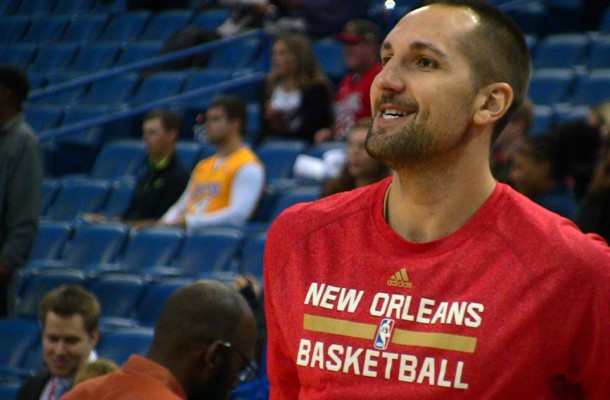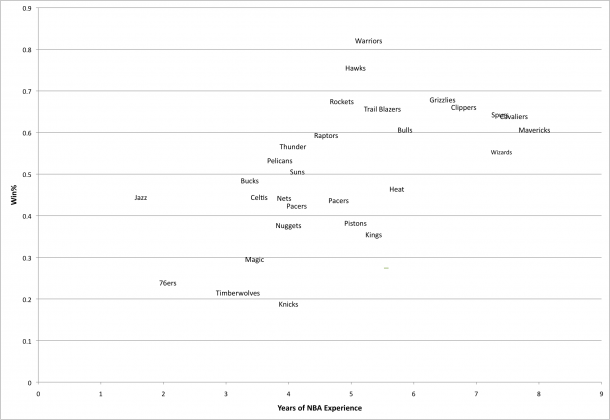“I do think that consistency in an organization is critical. If you want to have a chance to have success you have to have consistency; and it is consistency at the top management level, at the ownership level, but really the coach, I think, very much needs to build around a core group of key players who you know are going to be there for more than a year or two. I think without that, the coach and the core group that he can rely on, I think the chances of being successful are probably pretty slim.”
– Jonathan Kraft (President of the Kraft Group, New England Patriots, and part owner of the New England Revolution) on Building a Dynasty, 2014 Sloan Sports Analytics Conference
“The next step that’s gonna go into sports [analytics] is gonna be how to build chemistry. Its…its how to build the chemistry. Its not about approaching people about numbers and saying, you know, Joe Blow shoots 30% when he dribbles the ball once. If you can make him shoot it off the dribble make him do that, because he’s much, you know, much less efficient as a shooter. Its about all those things that create the bonds within players where they know if Joe Blow gets beat that they’re gonna be there to cover his butt…its the chemistry that tells guys exactly where this other player is going to be at this particular time on the floor.”
– Phil Jackson (President of the New York Knicks, former coach, former player in the NBA) n Building a Dynasty, 2014 Sloan Sports Analytics Conference
In 2002 a study was published in the Academy of Management Journal titled, “Tacit Knowledge as a Source of Competitive Advantage in the National Basketball Association.” The focus of the study was the relationship between sustained competitive advantage and tacit knowledge, which was represented through shared experience. The study looked at data from 23 teams over a period of 14 seasons to investigate how team performance (measured in total wins and total assists) was affected by “shared team experience” (an average was calculated for each team year from the years of experience each player had on a specific team weighted by the minutes played in games in that season by that player).
It is an interesting read, but I’ll keep it short and sweet here and skip over the math, though you can check out it yourself here. Here are the main findings I want to point out that relate to this Pelicans team:
- shared team experience was significant and positive in both models of team performance
- the returns of shared experience diminish after time, that is to say that the biggest and easiest gains come early in player relationships, and fewer gains come the longer players are together
- the performance effects are significant in the first two years and steadily decay over time
- the argument made that the teams performing best will have a mix of veterans and “young guns” is not supported by this study
All pretty obvious right? Success in sports doesn’t just come with getting the best players, but letting them grow together.
A similar study was published and presented at the 2012 Sloan Sports Analytics Conference titled, “Experience and Winning in the National Basketball Association.” This study, looking at data from 30 NBA franchises from 1978 to 2008, measured player experience, both individually and collectively (shared experience), and its effect on postseason success. Another very interesting piece, as you would expect from a study covered at the analytics conference, but again I’ll just summarize some of the major findings of the study:
- an ideal average player NBA experience level for a team is about 4.33 seasons played per player, the sample mean is 4.9 years per player, teams seem to operate around this level
- Postseason experience increases a team’s chances of making the playoffs while not necessarily increasing its chances of postseason success
- suggests that what should be assigned more attention is the value associated with keeping teammates together
So with all this in mind, here is some perspective on this years’ Pelicans (the numbers here are through April 1st, so even though the graph doesn’t show, the Pelicans now have a better win% than the Thunder, woo!):
Here we can see that no team has both a better record than the Pelicans and less experience than the Pelicans (who are one of just a few teams both young AND good). NOLA’s average of 3.86 years in the NBA is a whole year under league average 4.88. In addition to this, looking at postseason experience, every team with a higher win% than the Pelicans has a more postseason experience. If the Pelicans miss the playoffs, it might be because they didn’t have the “veteran experience” like Bruce Bowen recently suggested; but as the second study suggested, those veterans wouldn’t necessarily increases our chances of winning in the postseason in the years to come, and as the first study showed, the best teams are not the ones with an even mix of young and veteran players.
If the Pelicans fail to reach the playoffs this season, it would be natural for fans’ to want change. This team needs postseason experience to progress, and the postseason was the goal of the team to start the season. New Orleans basketball has not been in the postseason, or really had anything to play for post All-star break since 2010-11, the last year of the CP3 era. The 21-45 record the next year netted the team Anthony Davis and every year since then the Pelicans increased their win% (from .318 to .329 and then to .415). Now the team is over .500, and it’ll be the first time in the NBA careers of Jrue Holiday, Eric Gordon, Tyreke Evans, and Anthony Davis.
Below are the minutes (regular season) our core players have shared together, and some other combo’s to compare them to. Take note of the typical minutes played in a season for a Pelicans combo compared to some of the other teams, the difference is significant.
[table id=69 /] [table id=70 /]
To me, this team, this core has been denied a lot of the opportunity for growth that some of these other teams have. The Clippers, Warriors, and Blazers cores were established in the last 3-4 years, the Pelicans the last 2-3. These teams have had more opportunities to build through shared experience simply because they have had double, triple, quadruple the amount of time together on the court. Having been out of the playoffs a couple years, teams and their fan bases can get anxious, but even though this team has been together a couple years, we still do not know the ceiling of the team when healthy, and there is still a lot of opportunity for growth, significant growth (as you can see in the tables above, most of the core have not played two full seasons worth of basketball together). That may be frustrating to some but to me it is exciting, and it is a good thing. This team could miss out on the playoffs this season, and that would be disappointing; but the return of keeping this team together (similar to the last two years, say +7 wins) would seem to be enough to get this team 50+ wins, with a 22-23 year old Anthony Davis who STILL won’t be in his prime.
The one or two one or two late-game moments that could end up keeping the Pels out of the playoffs, in my eyes, are more easily addressed in house than with any major locker room change. This core has fought through a lot and made it this far with just a couple games left. We can keep our core of guys for a couple years, so lets take advantage of that. Flock Up!


One response to “All Aboard the Run It Back Train”
Great article…now we need to figure out how to keep them on the court to achieve it!